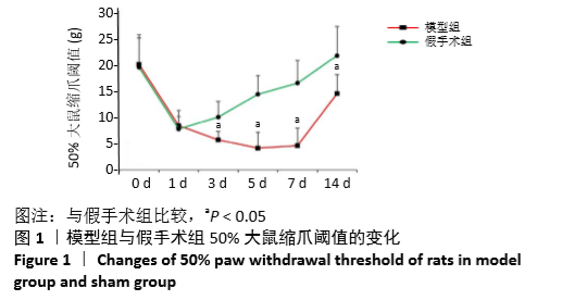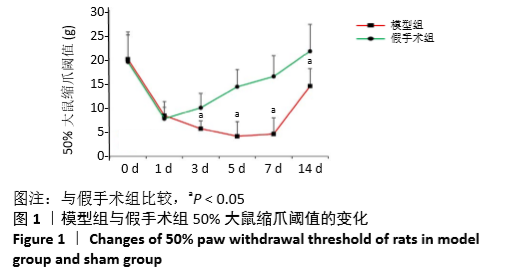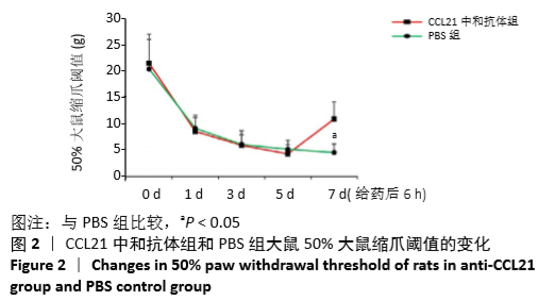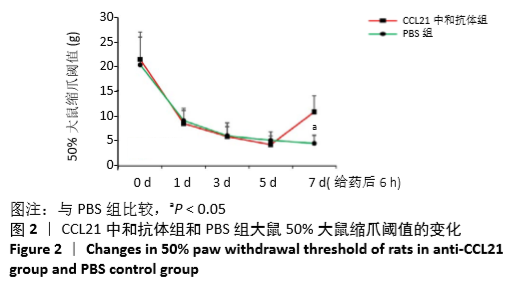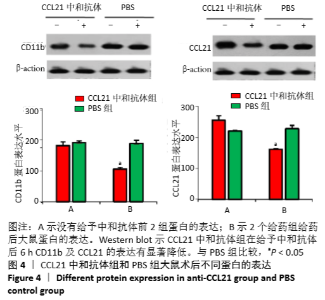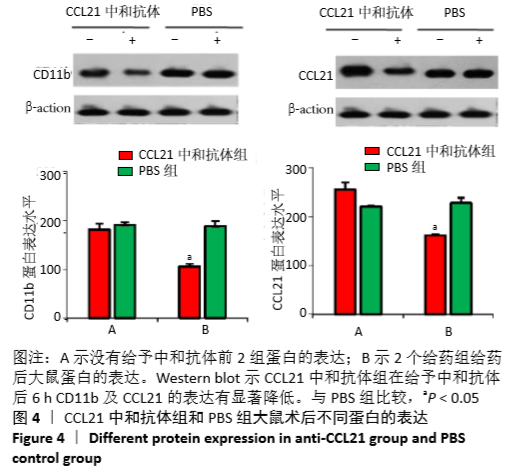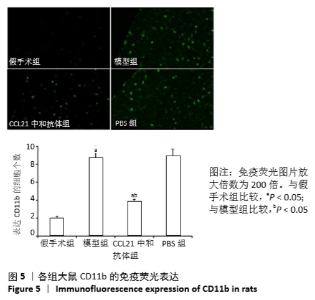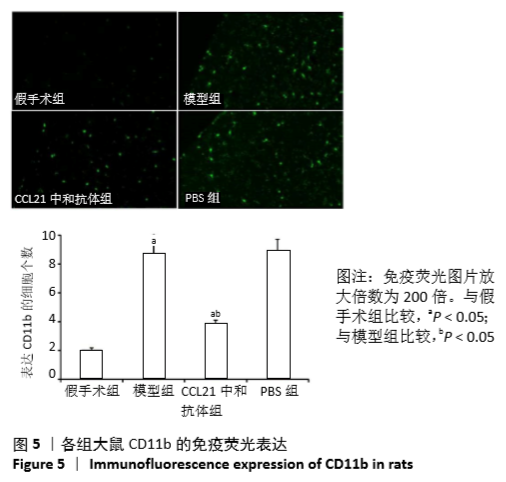Chinese Journal of Tissue Engineering Research ›› 2021, Vol. 25 ›› Issue (2): 242-246.doi: 10.3969/j.issn.2095-4344.2982
Previous Articles Next Articles
Chemokine CCL21 in anterior cingulate cortex is involved in chronic neuropathic pain in a rat model
Zhi Yibo1, 2, Zhang Jie2, Liu Jian1, 2, Li Weiyan1, 2
- 1Southern Medical University, Guangzhou 510000, Guangdong Province, China; 2Jinling Hospital Affiliated to Southern Medical University, Nanjing 210002, Jiangsu Province, China
-
Received:2019-12-25Revised:2019-12-27Accepted:2020-02-26Online:2021-01-18Published:2020-11-21 -
Contact:Li Weiyan, Chief physician, Professor, Southern Medical University, Guangzhou 510000, Guangdong Province, China; Jinling Hospital Affiliated to Southern Medical University, Nanjing 210002, Jiangsu Province, China Liu Jian, Associate chief physician, Professor, Southern Medical University, Guangzhou 510000, Guangdong Province, China; Jinling Hospital Affiliated to Southern Medical University, Nanjing 210002, Jiangsu Province, China -
About author:Zhi Yibo, Master, Physician, Southern Medical University, Guangzhou 510000, Guangdong Province, China; Jinling Hospital Affiliated to Southern Medical University, Nanjing 210002, Jiangsu Province, China
CLC Number:
Cite this article
Zhi Yibo, Zhang Jie, Liu Jian, Li Weiyan. Chemokine CCL21 in anterior cingulate cortex is involved in chronic neuropathic pain in a rat model[J]. Chinese Journal of Tissue Engineering Research, 2021, 25(2): 242-246.
share this article
Add to citation manager EndNote|Reference Manager|ProCite|BibTeX|RefWorks
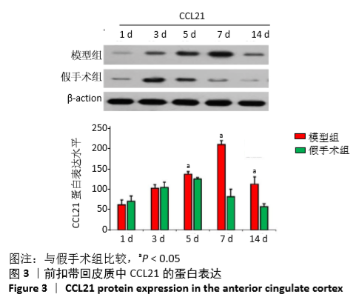
2.3 大鼠前扣带回皮质中趋化因子CCL21与CD11b表达变化 经过前5 d的急性损伤期,模型组术后第7天与假手术组相比,前扣带回皮质中趋化因子CCL21蛋白表达明显提高,而假手术组CCL21表达明显下降(P < 0.05),见图3。给予CCL21中和抗体以后,可见CCL21中和抗体组中大鼠前扣带回皮质CD11b、CCL21蛋白表达量较PBS组明显降低(P < 0.05),见图4。 2.4 大鼠前扣带回皮质区小胶质细胞免疫荧光变化 免疫荧光结果显示,假手术组前扣带回皮质中活化的小胶质细胞CD11b表达量较少。与假手术组相比,模型组活化的小胶质细胞明显增加,CD11b表达量明显较多。给予CCL21中和抗体以后,CCL21中和抗体组前扣带回皮质中CD11b表达量较模型组显著减少,PBS组CD11b表达量与模型组相比变化很小(P > 0.05),见图5。"
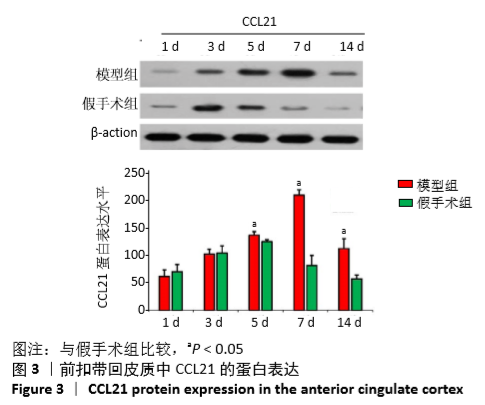
| [1] Jensen TS , Finnerup NB. Allodynia and hyperalgesia in neuropathic pain: clinical manifestations and mechanisms. Lancet Neurol. 2014; 13(9):924-935. [2] Arendt-Nielsen L , Morlion B, Perrot S, et al. Assessment and manifestation of central sensitisation across different chronic pain conditions. Eur J Pain. 2018;22:216-241. [3] Dahan A, van Velzen M, Niesters M. Comorbidities and the complexities of chronic pain. Anesthesiology. 2014;121:1-3. [4] Coyle DE. Partial peripheral nerve injury leads to activation of astroglia and microglia which parallels the development of allodynicbehavior. Glia. 1998;23(1): 75-83. [5] De Jong EK, Dijkstra IM, Hensens M, et al. Vesicle-mediated transport and release of CCL21 in endangered neurons:a possible explanation for microglia activation remote from a primary lesion. J Neurosci. 2005;25(33): 7548-7557. [6] Belsky J, Pluess M. Beyond diathesis stress: differential susceptibility to environmental influences. Psychol Bull. 2009;135(6): 885-908. [7] Verge GM, Milligan ED, Maier SF, et al. Fractakine (CX3CL1) and fractakine receptor (CX3CR1) distribution in spinal cord and dorsal root ganglia under basal and neuropathic pain conditions. Eur J Neurosci. 2004;20(5): 1150-1160. [8] Milligan ED, Sloane EM, Watkins LR. Glia in pathological pain: A role for fractalkine. J Neuroimmunol. 2008;198(1/2): 113-120. [9] Peoples LL. Neuroscience: will, anterior cingulate cortex, and addiction. Science. 2002;296(5573): 1623-1624. [10] Wei F, Guo W, Zou SP, et al. Supraspinal Glial-Neuronal interactions contribute to descending pain facilitation. J Neurosci. 2008;28(42): 10482-10495. [11] Milligan ED, Twining C, Chacur M, et al. Spinal glia and proinflammatory cytokines mediate mirror-image neuropathic pain in rats. J Neurosci. 2003;23(3): 1026-1040. [12] Wieseler-Frank J, Maier SF, Watkins LR. Central proinflammatory cytokines and pain enhancement. Neurosignals. 2005;14(4): 166-174. [13] Rappert A, Biber K, Nolte C, et al. Secondary lymphoid tissue chemokine (CCL21) activates CXCR3 to trigger a Cl- current and chemotaxis in murine microglia. J Immunol. 2002;168(7):3221. [14] Soto H, Wang W, Strieter RM, et al. The CC chemokine 6Ckine binds the CXC chemokine receptor CXCR3. Proc Natl Acad Sci U S A. 1998;95(14): 8205-8210. [15] Love M , Sandberg JL , Ziarek JJ , et al. Solution Structure of CCL21 and Identification of a Putative CCR7 Binding Site. Biochemistry. 2012; 51(3):733-735. [16] Tsuda M, Masuda T, Tozaki-Saitoh H, et al. P2X4 receptors and neuropathic pain. Front Cell Neurosci. 2013;7:191 [17] Jiang Y, Bai J, Tang L, et al. Anti-CCL21 antibody attenuates infarct size and improves cardiac remodeling after myocardial infarction. Cell Physiol Biochem. 2015;37(3):979-990. [18] Biber K, Boddeke E. Neuronal CC chemokines: the distinct roles of CCL21 and CCL2 in neuropathic pain. Front Cell Neurosci. 2014;8:210. [19] Xuan W, Qu Q, Zheng B, et al. The chemotaxis of M1 and M2 macrophages is regulated by different chemokines. J Leukoc Biol. 2014; 97(1):61-69. [20] Biber K , Tsuda M , Tozaki-Saitoh H , et al. Neuronal CCL21 up-regulates microglia P2X4 expression and initiates neuropathic pain development. Embo J. 2011;30(9):1864-1873. [21] Honjoh K, Nakajima H, Hirai T,et al. Relationship of Inflammatory Cytokines From M1-Type Microglia/Macrophages at the Injured Site and Lumbar Enlargement With Neuropathic Pain After Spinal Cord Injury in the CCL21 Knockout ( plt ) Mouse. Fronti Cell Neurosci. 2019; 21(9):525-526. [22] Detloff MR, Fisher LC, Mcgaughy V, et al. Remote activation of microglia and pro-inflammatory cytokines predict the onset and severity of below-level neuropathic pain after spinal cord injury in rats. Exp Neurol. 2008; 212(2):337-347. [23] Zhou X , He X , Ren Y. Function of microglia and macrophages in secondary damage after spinal cord injury. Neural Regen Res. 2014; 9(20):1787-1795. [24] Liu J, Feng X , Yu M , et al. Pentoxifylline attenuates the development of hyperalgesia in a rat model of neuropathic pain. Neurosci Lett. 2007; 412(3):268-272. |
| [1] | Li Shengkai, Li Tao, Wei Chao, Shi Ming. Comparison of biomechanical properties of calcium phosphate/polymethyl methacrylate composite bone cement and polymethyl methacrylate bone cement [J]. Chinese Journal of Tissue Engineering Research, 2022, 10(16): 2581-2586. |
| [2] | Liu Xiaojun, Xu Yuyin, Liu Kangbo, Zhou Jing, Han Ying, Xiong Yue, Tian Yuan. Preparation and properties of carboxymethylated cotton linters hemostatic gauze [J]. Chinese Journal of Tissue Engineering Research, 2022, 10(16): 2593-2599. |
| [3] | Yang Xue, Wang Baoqun, Jiang Xiaowen, Zou Shengcan, Ming Jinfa, Lin Shasha. Preparation and properties of biodegradable plant polysaccharide hemostatic microspheres [J]. Chinese Journal of Tissue Engineering Research, 2022, 10(16): 2607-2611. |
| [4] | Liu Jiali, Suo Hairui, Yang Han, Wang Ling, Xu Mingen. Influence of lay-down angles on mechanical properties of three-dimensional printed polycaprolactone scaffolds [J]. Chinese Journal of Tissue Engineering Research, 2022, 10(16): 2612-2617. |
| [5] | Luo Di, Liang Xuezhen, Liu Jinbao, Li Jiacheng, Yan Bozhao, Xu Bo, Li Gang. Difference in osteogenesis- and angiogenesis-related protein expression in femoral head samples from patients with femoral head necrosis of different etiologies [J]. Chinese Journal of Tissue Engineering Research, 2022, 26(11): 1641-1647. |
| [6] | Zhao Tianyu, Jin Song, Zhang Di, Liu Xiaoxiao, Ma Jiang, Wang Ju. Baduanjin training for patellar tendinopathy in a randomized controlled trial: improving pain, muscle flexibility and lower limb balance stability [J]. Chinese Journal of Tissue Engineering Research, 2022, 26(11): 1662-1668. |
| [7] | Zhang Lei, Xiu Chunmei, Ni Li, Chen Jianquan. Identification and expression analysis of mouse nucleus pulposus specific markers [J]. Chinese Journal of Tissue Engineering Research, 2022, 26(11): 1669-1674. |
| [8] | Li Jingyu, Su Yingying, Bai Ding. Morphological characteristics of subchondral bone in a mouse model of early osteoarthritis [J]. Chinese Journal of Tissue Engineering Research, 2022, 26(11): 1692-1698. |
| [9] | Bao Hongyu Lü Dongmei, He Yun, Xia Delin, Chen Junliang. Incidence of osteonecrosis in rats with jaw versus femoral defects following zoledronic acid injection [J]. Chinese Journal of Tissue Engineering Research, 2022, 26(11): 1699-1704. |
| [10] | Tan Qian, Li Bocun, Li Jing, Li Jia, Xiang Hongchun, Cai Guowei. Acupuncture combined with moxibustion regulates the expression of circadian clock protein in the synovium of rats with osteoarthritis [J]. Chinese Journal of Tissue Engineering Research, 2022, 26(11): 1714-1719. |
| [11] | Fei Jing, Tao Meihui, Li Leiji. Electroacupuncture promotes facial nerve regeneration in a rat model of facial nerve crush [J]. Chinese Journal of Tissue Engineering Research, 2022, 26(11): 1728-1733. |
| [12] | Yu Basuo, Sun Mingyun, Yang Hongmei, Bao Yaling, Qian Zhenyu, Meng Haijiang, Zhou Duoqi. Characteristics and influencing factors of carotid blood flow in younger adults in different body positions [J]. Chinese Journal of Tissue Engineering Research, 2022, 26(11): 1734-1740. |
| [13] | Che Yanjun, Hu Dan, Si Weibing, Gu Xueping, Hao Yuefeng. Bone cement interval perfusion in hyperextension position for treatment of senile osteoporotic vertebral compression fractures [J]. Chinese Journal of Tissue Engineering Research, 2022, 26(10): 1483-1489. |
| [14] | Li Wenle, Wang Haosheng, Ning Lijun, Zhang Wenshi, Gao Sen, Sun Lijun, Hu Zhaohui. Analysis of the risk for bone cement leakage after percutaneous vertebroplasty in osteoporosis patients and model verification [J]. Chinese Journal of Tissue Engineering Research, 2022, 26(10): 1477-1482. |
| [15] | Shi Yan, Zhang Yunqing, Liu Yong, Rui Min, Liu Shanglou. Kyphoplasty with high viscosity bone cement for the treatment of stage III Kümmell disease without neurological symptoms: restoration of vertebral body height, reduction of kyphoplasty and restoration of column sagittal sequence [J]. Chinese Journal of Tissue Engineering Research, 2022, 26(10): 1490-1494. |
| Viewed | ||||||
|
Full text |
|
|||||
|
Abstract |
|
|||||
